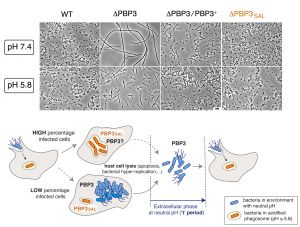Scientists at the Centro Nacional de Biotecnología of the CSIC (CNB-CSIC), in collaboration with researchers at the Severo Ochoa Centro de Biología Molecular and the Universidad Autónoma de Madrid, have described a mechanism used by the bacterium Salmonella enterica to multiply within the cells it infects. They found that the bacterium has two division machineries, used alternatively outside and inside the host cell. To date, all bacteria were thought to use only a single division machinery during growth.
The study, published in the journal mBio, identifies a Salmonella enzyme that is only active in acidic environments and is not found in harmless environmental bacteria. This enzyme, which produces the peptidoglycan septum that physically separates the daughter cells, has low affinity for beta-lactam antibiotics in common clinical use. The authors term this enzyme PBP3SAL, to distinguish it from its equivalent PBP3 in the classical division system. According to the report, Salmonella uses PBP3SAL preferentially to divide inside the phagosomal compartments of an infected cell whose pH is acid. This is the first evidence that, in response to distinct environmental conditions, two different enzymes are able to build the bacterial division septum independently.
"Our results question the current theory that actively growing bacteria have only a single division machinery," says Francisco García del Portillo, CNB-CSIC scientist and author of the study. “We must continue to study the role of this new enzyme, which is able to promote division within the host cell, since the known beta-lactam antibiotics do not effectively slow its activity. New compounds are therefore needed to control the intracellular infection.”
The study was conducted using the Salmonella enterica serovar Typhimurium, a pathogenic microorganism that infects the mammalian digestive tract. This bacterium has a life cycle that alternates division outside and inside the cell. "Our discovery broadens knowledge of S. typhimurium. Division of this bacterium seems to be programmed differently for extra- and intracellular life. It remains to be determined what benefits PBP3SAL offers compared to PBP3 during division of the pathogen in the eukaryotic cell", concludes García del Portillo.
- Sónia Castanheira, Juan J. Cestero, Gadea Rico-Pérez, Pablo García, Felipe Cava, Juan A. Ayala, M. Graciela Pucciarelli, Francisco García-del Portillo. A Specialized Peptidoglycan Synthase Promotes Salmonella Cell Division inside Host Cells. MBio. 2017 Dec 19;8(6)






